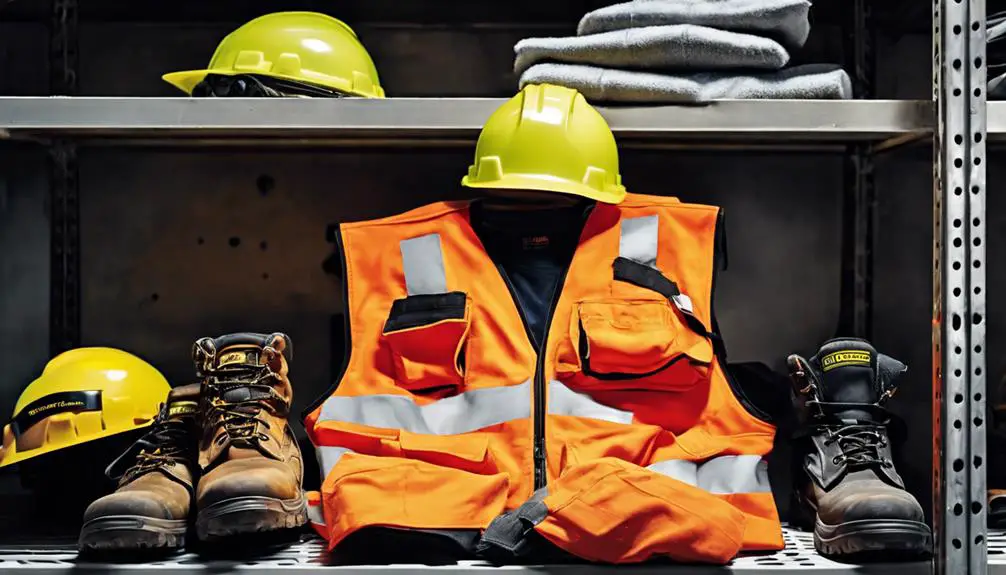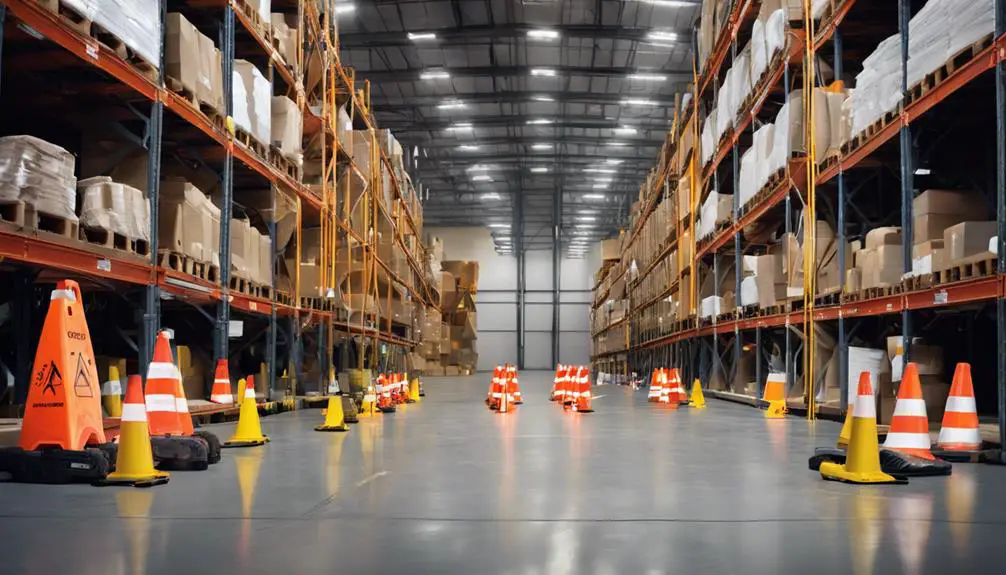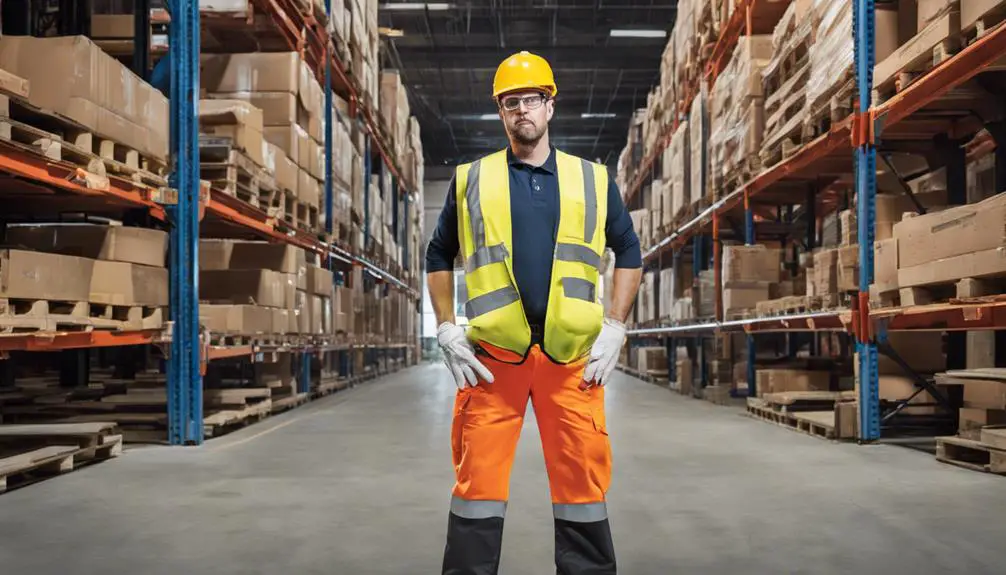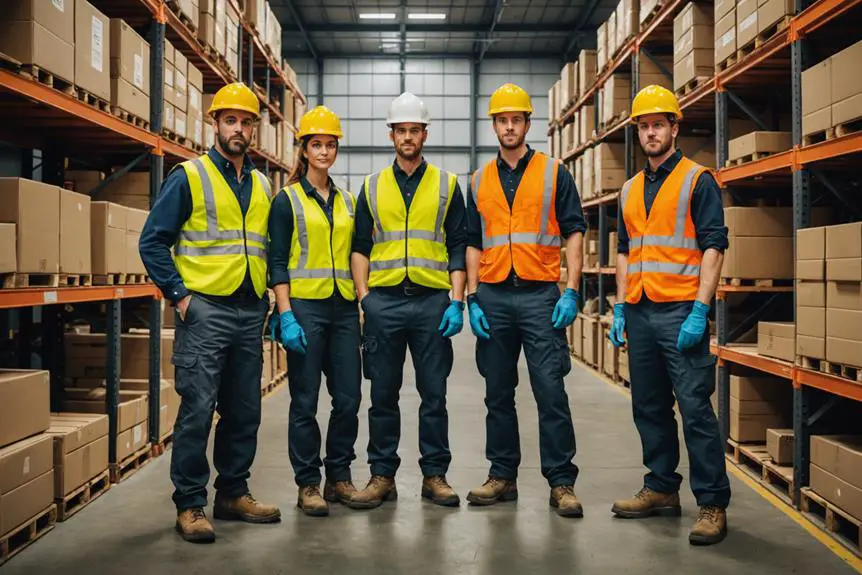To dress as a warehouse worker, focus on safety, comfort, and functionality. Start with durable work trousers for easy movement and moisture-wicking base layers to stay dry. Always wear steel-toed boots with slip-resistant soles to protect your feet from heavy items and prevent slips. High-visibility vests are vital in bustling environments, while avoiding loose clothing and accessories reduces safety hazards. Furthermore, consider layering with insulation for chilly conditions and a waterproof jacket for wet environments. Don't forget additional safety gear like gloves and hard hats! As you explore more about this topic, you'll uncover even more essential tips to optimize your wardrobe.
Warehouse Dress Code Essentials

When working in a warehouse, you'll often find that the dress code prioritizes safety, comfort, and functionality. This means you'll need to pay close attention to the clothing items you choose each day. An appropriate dress code is vital for ensuring you're protected while performing physical tasks. Start with durable work trousers that can withstand the rigors of your job; they should allow for a full range of motion without being too loose.
Personal protective equipment (PPE) is essential, so you might be required to wear high-visibility vests in busy environments. These vests not only enhance your visibility but greatly reduce the risk of accidents, which is a top safety concern. Pair those with steel-toed boots, which are designed to protect your feet from heavy items and potential hazards on the floor.
It's also important to avoid loose clothing, open-toed shoes, and any accessories like scarves or ties that could get caught in machinery. These items pose considerable safety risks and can lead to serious injuries. Depending on the season, you may need to adjust your wardrobe for ideal comfort and protection against temperature fluctuations.
Layering for Temperature Control
Layering is key to staying comfortable in a warehouse, especially as temperatures can fluctuate throughout your shift. By mastering the art of layering, you can achieve ideal temperature control, which directly impacts your comfort and productivity. Start with a base layer made of moisture-wicking materials like polyester or nylon. This layer helps keep your skin dry, allowing sweat to evaporate rather than cling to you, preventing that clammy feeling that can be so distracting.
Next, add a middle layer for insulation. Fleece or wool options work wonders in trapping warmth without adding too much bulk. This is essential for those chilly mornings or when you're working in cooler areas of the warehouse. You want to stay warm but not overheated, so adjust this layer based on your activity level.
Finally, don a durable jacket as your outer layer. This layer is your first line of defense against environmental elements like wind and moisture. A good jacket will not only keep you dry but also add an extra barrier against the cold, ensuring you stay focused on your tasks.
Effective layering allows you to adapt your clothing to changing conditions, keeping you comfortable and boosting your productivity. Remember, the right combination of layers can make all the difference in your day-to-day warehouse experience. So gear up wisely, and you'll be ready to tackle whatever comes your way!
Footwear Safety Requirements

Staying comfortable in a warehouse isn't just about the layers you wear; your footwear plays a significant role in your safety and well-being. Choosing the right footwear is essential to protect your feet from potential hazards, especially from falling objects. Steel-toed boots are often a common requirement for heavy lifting tasks, providing critical protection while you work.
In a bustling work environment, slip-resistant soles are important. They help prevent falls in areas where spills may occur, ensuring you have better traction on slippery surfaces. Remember, closed-toe footwear is mandatory—open-toed shoes are a no-go due to the increased risk of injury. Keeping your feet protected is a top priority!
If you find yourself standing or walking for extended periods, wedge sole boots are your best friend. They offer comfort that can reduce fatigue, making those long shifts a bit easier. Additionally, waterproof shoes may be necessary in environments where spills or wet conditions are prevalent. Keeping your feet dry and comfortable will help you stay focused on the task at hand.
Clothing Restrictions and Prohibitions
In a warehouse environment, adhering to clothing restrictions is essential for your safety and efficiency. These guidelines not only protect you but also enhance your professional appearance. Here are three important clothing restrictions you should keep in mind:
- Avoid Loose Clothing: Loose clothing can easily get caught in machinery, leading to serious accidents. Opt for fitted garments that allow you to move freely without posing a risk.
- Ditch the Accessories: Accessories like scarves and ties may seem stylish, but they can become entangled in equipment, jeopardizing your safety. Stick to minimalistic, practical attire.
- Say No to Open-Toed Shoes: Open-toed shoes, flip-flops, and sandals leave your feet exposed to injuries from falling objects or heavy machinery. Guarantee that you wear closed-toe shoes that offer proper protection.
Additionally, consider the color of your clothing. Light colors tend to show dirt easily, making it challenging to maintain a professional look. Instead, opt for darker colors that are practical and easier to keep clean. Jewelry should also be avoided, as it can snag on equipment and create safety hazards.
Additional Safety Gear Considerations

A warehouse worker's safety gear plays an important role in preventing injuries on the job. Utilizing the right personal protective equipment (PPE) not only safeguards you but also promotes a culture of warehouse safety among all employees. Consider the following important safety gear to keep you protected:
| Safety Gear | Purpose |
|---|---|
| Safety Gloves | Protect hands from cuts, chemicals, and abrasions |
| High-Visibility Safety Apparel (HVSA) | Guarantee visibility in busy and low-light areas |
| Hard Hats | Protect against head injuries from falling objects |
| Hearing Protection | Minimize risk of hearing damage in noisy environments |
| Regular Inspections | Verify gear effectiveness and compliance with regulations |
When selecting safety gloves, remember to choose based on the hazards you might encounter. For instance, cut-resistant gloves are significant if you're handling sharp objects, while chemical-resistant gloves are crucial when dealing with hazardous materials. High-visibility safety apparel (HVSA) is a must-have, particularly in busy warehouses or loading docks, where visibility can be compromised.
Hearing protection, such as earplugs or earmuffs, is critical in loud environments to help prevent permanent hearing damage. Finally, don't forget about regular inspections and maintenance of your safety gear. Worn-out equipment can compromise your safety, so keeping everything in working order is important. By prioritizing these additional safety gear considerations, you're not just protecting yourself; you're fostering a safer workplace for everyone.
Frequently Asked Questions
What Is the Dress Code for Warehouse Workers?
The dress code for warehouse workers emphasizes safety regulations. You'll want to choose breathable fabrics, comfortable footwear options, and consider layering techniques for seasonal attire. Prioritize personal comfort while adhering to color considerations and protective gear requirements.
What Should I Wear in a Warehouse?
When you're in a warehouse, think of your attire as armor. Choose durable materials, breathable fabrics, and comfortable footwear. Layer for weather considerations, add high visibility clothing, and always include essential safety gear and personal protective equipment.
What Not to Wear in a Warehouse Job?
You shouldn't wear loose clothing or scarves, as they pose safety hazards. Avoid open-toed footwear and light colors. Prioritize comfort, visibility, and protective gear while considering weather and layering techniques for better adaptability.
How to Look Good at a Warehouse Job?
To look good at a warehouse job, you'll want stylish safety gear, practical footwear, and breathable fabrics. Use durable materials and layering techniques for weather adaptability, adding personal flair with functional accessories to complete your look.




